Day 1 of a 5 day Autumn Tour today. The weather was kind to us – some sun and blue skies, some patchy cloud – although it was cool at times in the blustery west wind. With the possibility of a tiny window of wind coming in off the continent overnight, we headed for Burnham Overy first thing to see if we could find any fresh migrants.
As we got out of the car, we could see a couple of flocks of Golden Plover overhead, alternately flashing bright white underwings and gold spangled upperparts as they turned in the morning sun. The hedges on the walk out are full of berries – ready for the autumn thrushes. A Chiffchaff called from one side and a Goldcrest flitted across on the other side, calling – the latter as likely a migrant arrived from the continent than a resident. The fields were full of Curlews – and a large flock of Egyptian Geese.
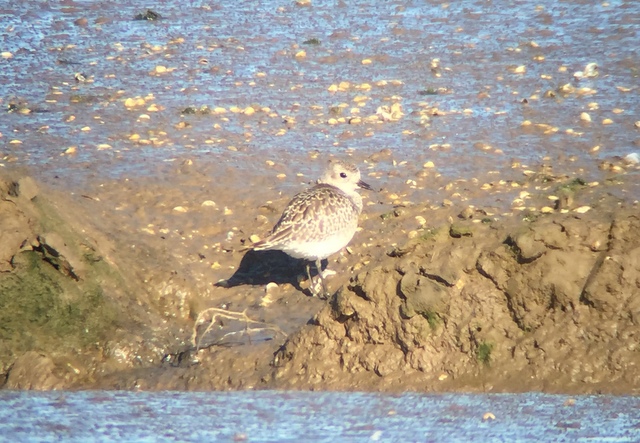 Grey Plover – out on the saltmarsh at Burnham Overy
Grey Plover – out on the saltmarsh at Burnham Overy
From the seawall, we scanned across the saltmarsh and Burnham Overy Harbour. With the tide out, there were lots of Redshank on the mud and a couple of Grey Plover in amongst them. Further over, in the channel, a flock of Wigeon dropped in and behind them we picked up a small group of Dunlin feeding on the edge. A party of plain-looking Knot came up from the harbour and flew out towards the beach.
The reedbed pool was quiet today. A Little Grebe appeared briefly, but headed quickly for the reeds. It was a bit too exposed and windy out there. We could hear Bearded Tits calling but they were staying tucked down, out of the wind. We did get a quick glimpse of a grey-headed male as he flew across the reeds just before he dropped back into cover. A group of five Skylarks flew over us as we walked out along the bank.
The bushes by the boardwalk are a very good spot for migrants when birds are arriving but they were quiet as well today. There were a few of the resident Linnets and Dunnocks present, as usual. However, the area was very disturbed, with Holkham Estate staff replacing the fence all the way between the boardwalk and the west end of the pines today. A couple of butterflies were sunning themselves – a Comma wouldn’t settle for long but a Small Heath performed nicely in the brambles. We decided to walk east into the dunes, towards the pines.
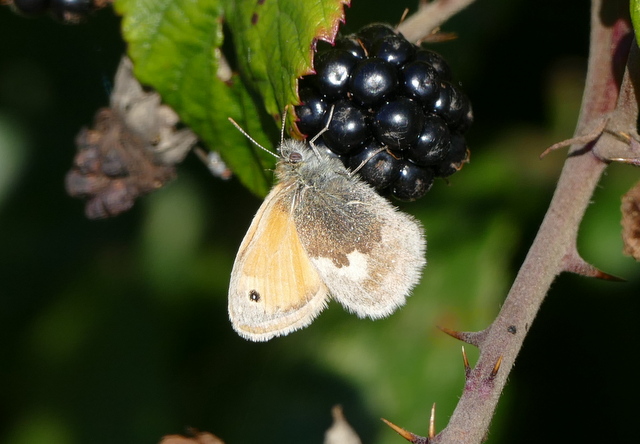 Small Heath – sunning itself on the brambles by the boardwalk
Small Heath – sunning itself on the brambles by the boardwalk
The massive movement of Siskins along the coast has been the standout feature of recent weeks, but numbers have clearly now tailed off. We did have a couple of small flocks of Siskin flying west over the dunes today, but not the numbers we have seen recently. A flock of three Redpoll also flew over us, calling.
We hadn’t gone far into the dunes when we came across a Wheatear. They like the short grass and lichen-covered slopes and hollows out here. It dropped over a ridge out of view, so we climbed up to get a better look at it. It would perch up on dead plant stems or hillocks before flitting back down to the ground looking for food, flashing its white tail base as it did so.
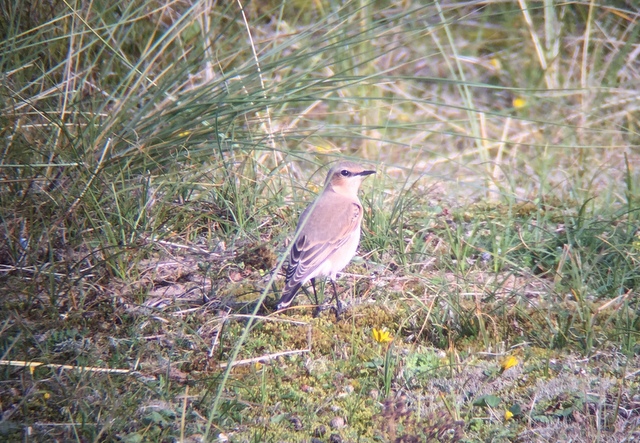 Wheatear – feeding out in the dunes today
Wheatear – feeding out in the dunes today
A little further on, in the bushes on the south side of where the fence would normally be, we glimpsed what appeared to be two Whinchats briefly. We were looking east into the sun, so repositioned ourselves to get a better view. After a short while, a pair of Stonechats appeared nearby – perhaps we were mistaken about the Whinchats? We got them in the scope and had a good look at them – the black-faced male and brown-cheeked female Stonechat – before they worked their way west in the direction we had just come. More of the fencing crew were right where the chats were trying to feed, with loud machinery, so we decided to carry on and swing back this way later.
The bushes by the west end of the pines were also rather quiet, but a scan of the grazing marshes revealed a small flock of 30+ Pink-footed Geese out on the grass. They have just begun to return from Iceland in the last couple of weeks and numbers are very slowly starting to increase. We got them in the scope and could see their dark heads and small, mostly dark bills. A short while later a large skein of about 200 geese appeared over the fields way off to the south, beyond the coast road. As they gradually got closer we could hear them calling – more Pink-footed Geese – and half of them whiffled down onto the marshes (the rest carried on west towards Holkham).
We couldn’t find any other migrants in the dunes, so we turned to head back. About half way to the boardwalk, a couple of birds appeared in the bushes by the old fence line. We stopped and got the scope on them – Whinchats, just along from where we had seen them earlier. Then another two appeared, probably disturbed by the fencing activity. We got a great look at them in the scope, noting their distinctive pale supercilium, and the differences between the different birds ranging from rather pale and washed out to one with quite a strong orange coloured breast.
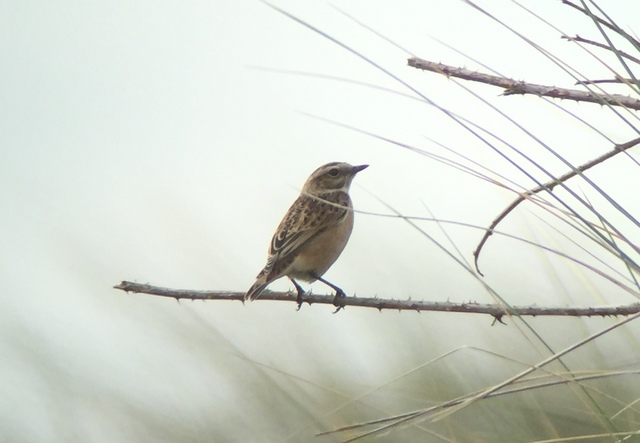 Whinchat – we eventually tracked down four in the dunes
Whinchat – we eventually tracked down four in the dunes
Back at the boardwalk, we stopped to admire several Golden Plover which had dropped down onto the saltmarsh. They are remarkably well camouflaged amongst the vegetation out here. Then we made our way back to the car.
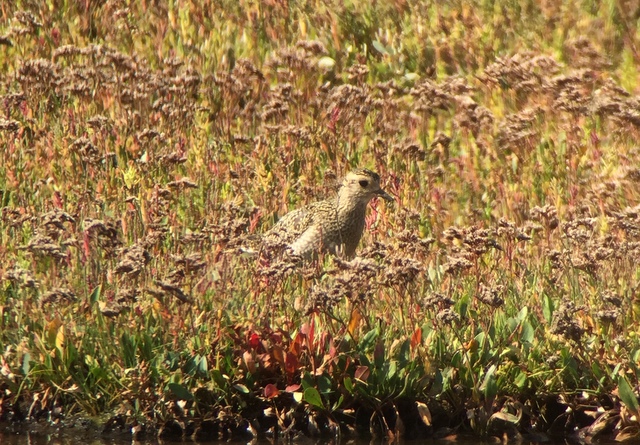 Golden Plover – well camouflaged among the dead sea lavender flowers
Golden Plover – well camouflaged among the dead sea lavender flowers
Our next destination was Wells, but we took a little detour inland on the way there. As we drove, we glimpsed a Red Kite over the fields beyond the hedge. Pulling in at the next farm track, we could see it drifting lazily over, flashing its red, forked tail. Further along the track, a covey of nine Grey Partridge appeared. They ran along, making a couple of failed attempts to get into the cover of the verge, before finally getting round the corner out of view. A little further on, another three Grey Partridge were feeding quietly in a cultivated field. When they crouched down, they looked to all intents and purposes like clods of earth.
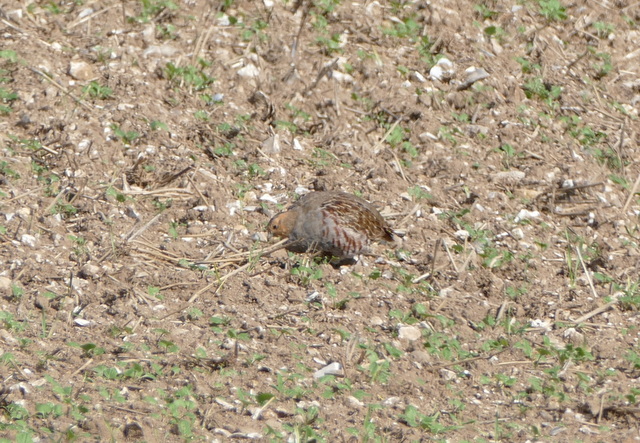 Grey Partridge – one of at least 12 we saw on a short detour en route to Wells
Grey Partridge – one of at least 12 we saw on a short detour en route to Wells
We headed down to Wells beach car park for lunch and afterwards walked back to take a quick look in the harbour. The tide was coming in, but there were still several waders feeding on the mud on the far side – mainly Curlews and Oystercatchers. Three juvenile Ringed Plover were trying to roost on a rapidly disappearing island. While we were scanning through the waders we picked up two ducks in the harbour channel – two redhead Red-breasted Mergansers. They were diving constantly, so were hard to get in the scope, but we all managed to see them eventually.
When a Sanderling flew past down the channel and disappeared round the corner past the lifeboat station, we decided to walk over to the beach to take a look from there. There were a lot more waders on that side – lots of Oystercatchers and, next to them, quite a nice flock of Knot with a few Dunlin mixed in. On a sand bar mid-channel, were a little huddle of Sanderling and a few Bar-tailed Godwit.
 Peregrine – a juvenile out on one of the harbour sandbars
Peregrine – a juvenile out on one of the harbour sandbars
Further out, towards the sea, we could see a Peregrine out on the sand. We got it in the scope and could see that it was a young bird. We watched it for a while sitting patiently and then, having taken our eyes off it, a short while later it appeared closer in, just behind the wader flock, eyeing them up hungrily. A Marsh Harrier drifted across the channel towards us as well, from the direction of East Hills.
 Peregrine – edging its way closer to the unsuspecting waders
Peregrine – edging its way closer to the unsuspecting waders
There was also a good-sized flock of Brent Geese out in the harbour – these geese too are just starting to gather for the winter, in this case returning from Russia. Beyond the sandbar, over the open sea, we picked up a couple of Red-throated Divers and a Gannet, flying past distantly.
We spent rather longer looking in the harbour than we had anticipated, so we didn’t leave ourselves as much time to explore Wells Woods as we would perhaps have liked. However, the trees were very quiet at first as we walked through. A Chiffchaff called from the birch trees.
 Common Darter – sunning itself out of the wind
Common Darter – sunning itself out of the wind
We couldn’t find any trace of any of the tit flocks at first, not even around the drinking pool which has been a favoured area in recent days. We did see a nice Goldcrest low overhead in the pines and a Treecreeper working its way straight up a trunk nearby. Walking a little further along the main track, we encountered the surprise of the day. We heard them first – the distinctive ‘teesz’ call of Redwings. They dropped down out of the trees and into the brambles over an overgrown bank. Unfortunately as we climbed quietly up to try to see them, they flew off west, calling again. It is not long now before the hedgerows will be full of Redwings and Fieldfares, arriving from the continent and feasting on all the berries. However, these are the first Redwings of autumn we have seen.
As we worked our way back towards the car park, we finally found a flock of Long-tailed Tits and with them, Blue Tits, Coal Tits, Goldcrests and Treecreepers. They were feeding on the edge of the pines and we didn’t know where to look as the came past us – birds everywhere, but none of them sitting still for long. However, we had a good look but there was no sign today of the hoped for Yellow-browed Warbler amongst them.
Back at the car park, we were just walking back to the car when a Hedgehog appeared from the verge and started to walk out into the road. A passing car only just missed it. It was strange to see it out and about at this time of day and it seemed a little lethargic – perhaps it was not well? However, it turned and managed to burrow its way into the grass, finding a gap through the fence and deep into the brambles. Hopefully it will be OK. All too soon, it was then time for us to head for home.

















